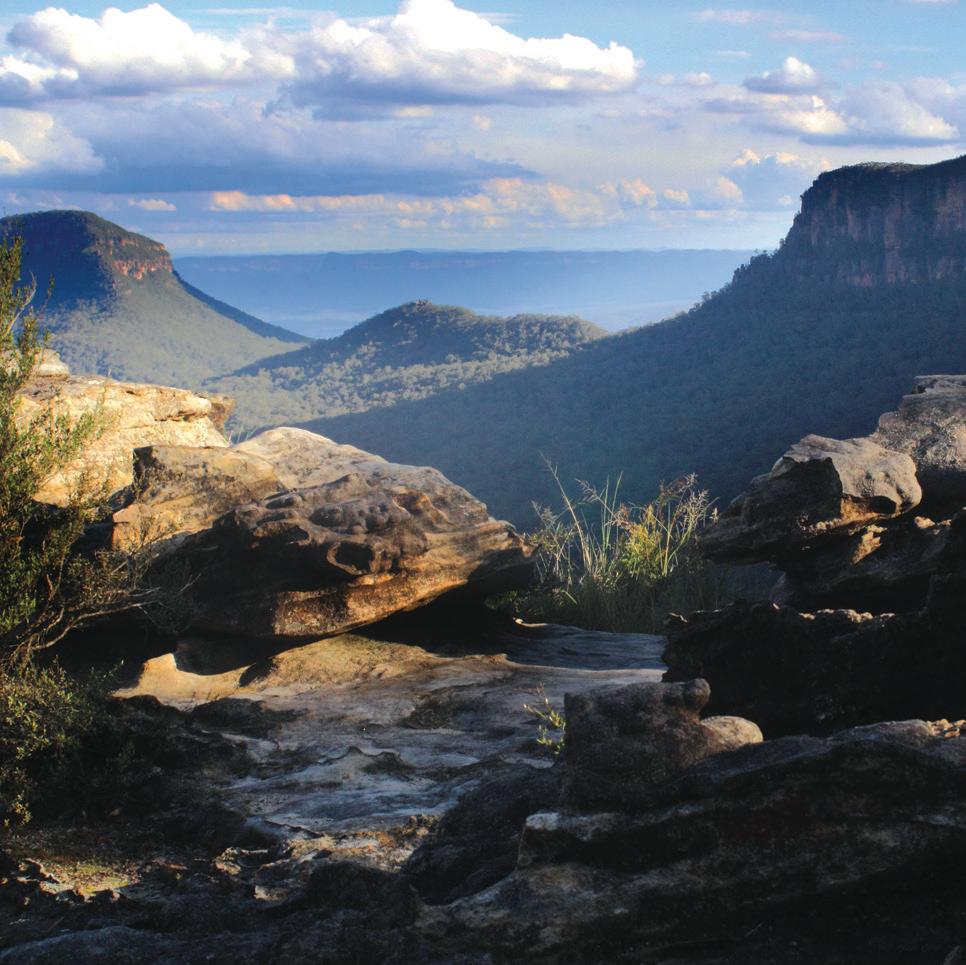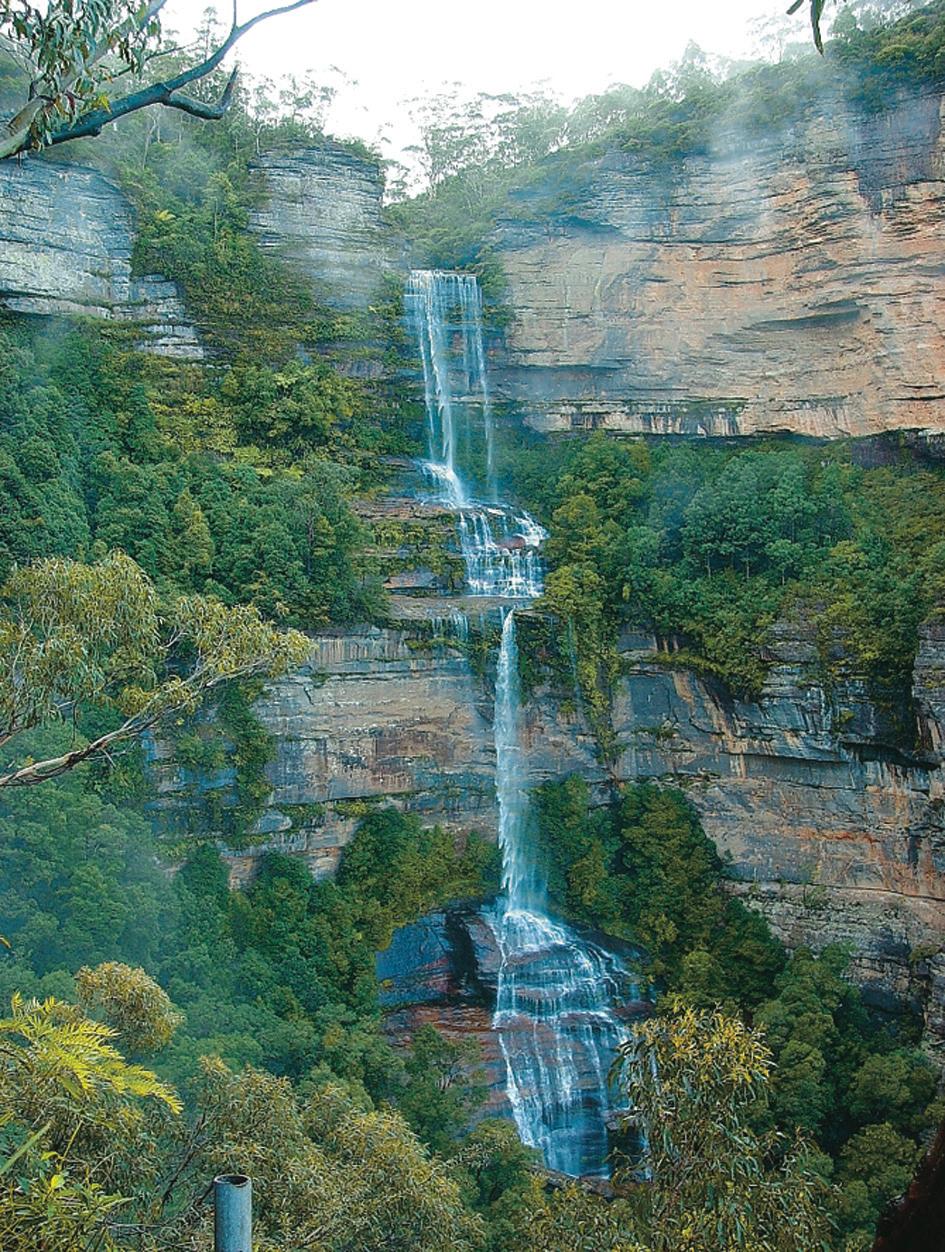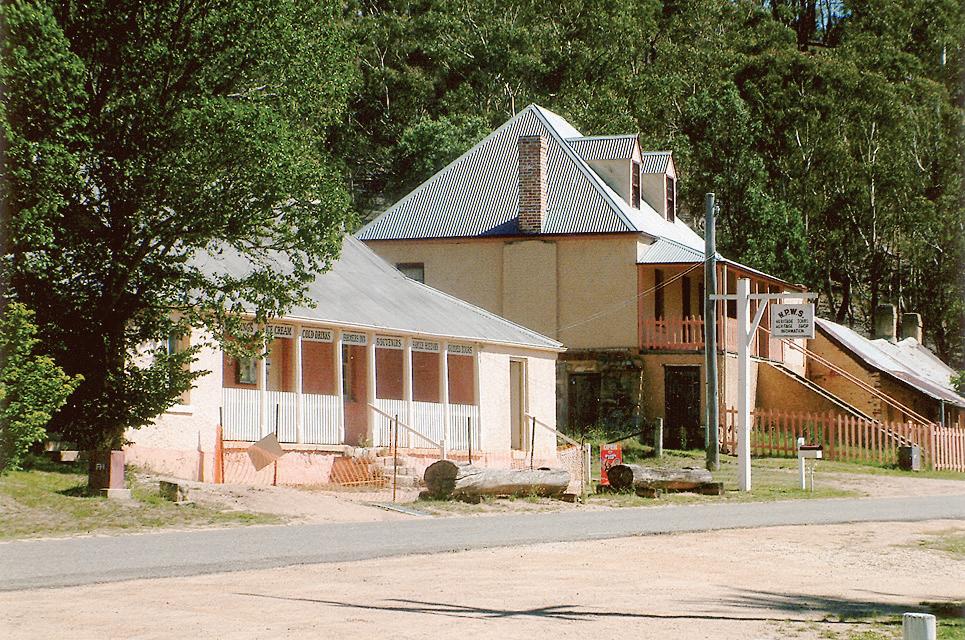
15 minute read
Katoomba Town
The most visited village in the Blue Mountains, Katoomba is where the young Royals were ushered to take in one of the most spectacular sights in the country – the Three Sisters, which tower above the Jamison Valley and stand at 922, 918 and 906 metres respectively. According to Aboriginal dreamtime legend, three sisters named Meehni, Wimlah and Gunnedoo were turned to stone for their own protection after being forbidden to marry three brothers from a different tribe.
Echo Point, perched on the edge of the escarpment and offering a direct view of the Three Sisters, is where several of Katoomba’s finest walking trails begin. The Giant Stairway, comprising eight hundred steps, leads down to the valley floor and joins The Federal Pass trail – a 1.5-kilometre track that takes you to the base of Katoomba Falls and the Scenic Railway, which you can catch back up to the top.
On a clear day, take the Skyway tour at Scenic World to get a genuine sense of the vastness and magnificence of the Blue Mountains. Gliding between cliff tops, the Skyway is Australia’s highest cable car – suspended two hundred and seventy metres above ancient ravines, it has a glass floor so you can see as much of the valley as possible during the seven hundred and twenty-metre journey.
Once you come back down to earth you can discover the tranquillity of the ancient rainforest by taking the 2.4-kilometre Scenic Walkway. It’s an opportunity to learn about local flora, spot a lyrebird, taste pure water straight from Marrangaroo Spring and learn about the site’s history as a coal and shale mine that was operational until 1945.

Also of historical interest is the site known as The Gully, in South Katoomba, which holds great cultural significance to its traditional owners, the Gundungurra and Darug peoples. Prior to white settlement of the region, this natural amphitheatre was long used as a summer camp. After being controversially repurposed as a racetrack in 1957, The Gully was officially declared an Aboriginal Place in 2002, a move warmly welcomed by its traditional custodians. Visitors are invited to experience The Gully Aboriginal Interpretive Walk, which starts on Gates Avenue.
Railway buffs will be interested to know that, back in 1874, the locality was named The Crushers after the railway station that served the nearby quarry, which crushed stone to form railway ballast and directly led to the original development of the area. In 1877 the town was renamed Katoomba – a derivative of the Aboriginal word Kedumba, meaning ‘shiny, falling waters’ – and it was given municipality status in 1889.

(top left) Mountain Stream by Denys Joannes (next down) Carrington Hotel by night (next down) Blue Mountains Cultural Centre (bottom left) Town centre clock, Katoomba (below) Fern Glade, Katoomba by David Burke


Today Katoomba is home to over 8,000 residents and hosts a constant stream of tourists from all around the world. Along with its strong ecological and cultural heritage, the town boasts many fine examples of Art Deco shops, restaurants and guesthouses, as well as charming old miners’ cottages and Federation bungalows. The jewel in the architectural crown is The Carrington Hotel – a grand Victorian property designed by John Kirkpatrick. Originally known as the Great Western Hotel, it was opened by Sydney hotelier Harry Rowell in 1883. Beautifully preserved and a popular destination for weddings and events, The Carrington has long been attracting guests keen to absorb the magic and grandeur of a bygone era. At the back of the hotel you’ll find Carrington Cellars, which is filled to the brim with local, national and international wines plus an impressive selection of deli items.
Katoomba has long had a thriving music scene and the annual Blue Mountains Music Festival sees folk, roots and blues performers from all around the globe coming together here. Running for twenty years, up to one hundred performances are conducted over three days each March. Past guests have included the incomparable Gurrumul, Lior, Xavier Rudd, Chipolatas, Arlo Guthrie, Luka Bloom, Mama Kin, The Popes and Kate Miller-Heidke.
During your stay, seize the opportunity to explore the Blue Mountains Cultural Centre – an inspired addition to a village that many artists, photographers and performers call home. Officially opened in November 2012, this substantial art space supports local and visiting artists, and houses the World Heritage Exhibition, where you can learn all about the region’s history and culture. There’s also a scenic viewing platform and a retail space, café and ultra-modern library housed here.
After a day spent absorbing the beautiful surrounds, mixing with locals in cafés, enjoying the architecture or digging up treasures in the well-stocked antique stores, take your pick from the countless restaurants. ‘... According to Aboriginal dreamtime legend, three sisters named Meehni, Wimlah and Gunnedoo were turned to stone for their own protection after being for bidden to marry three...’


(above) Into the Jamison Valley from Narrow Neck, Katoomba (left) The spectacle of Katoomba Falls (below) The Three Sisters from Echo Point,Katoomba




Originally named Hounslow, this Upper Blue Mountains village was renamed by Governor Macquarie in 1815, in reference to the colour and texture of the native shrubbery in the area. Thought to be a summer corroboree meeting place for peoples of the Darug, Gundungurra and Wiradjuri tribes, Blackheath developed into a fully fledged town after the Main Western railway line was built in 1869.
Located between Medlow Bath and Mount Victoria, the village sits at an altitude of 1065 metres and is close to the highest point in the region. The air here is crisp and it sometimes snows in winter and spring. There’s plenty of colonial history to experience, starting with a walk along Govetts Leap Road.
The first building to appear in Blackheath was The Scotch Thistle Inn, built by Andrew Gardner in 1831 and famously visited by Charles Darwin in 1836. The oldest licensed hotel in the Blue Mountains, it is now known as the Gardners Inn Hotel and is a popular spot for a great pub feed and game of pool.
Another notable site is the Victory Theatre, a 1915 Art Deco building that has been converted from a cinema into a fabulous antiques centre. It’s set over two levels and has a café in the original foyer area. Next door is an arcade which houses a number of good shops including Colliers Crystals where you can view or buy all manner of rock samples, gems, jewellery, salt lamps and many other interesting items.
Take a wander around the village’s retail strip and you’ll discover a well-curated mix of shops, cafés and galleries set within beautiful old buildings. If you happen to be visiting on the second Sunday of the month, don’t miss the buzzy Blackheath Growers Market said to be the best growers’ market in the region –it’s where regional providores, producers and plant sellers gather, and it’s a great indication that the local food scene is thriving. It’s held adjacent to the community centre in Memorial Park on the highway opposite the railway station.
One of the village’s most colourful residents is the artist and fashion designer Jenny Kee, a passionate fan of the Australian bush. Jenny has taken the waratah as her personal emblem and is responsible for designing the fabulous mural on the outside of the Victory Theatre, which was painted in 1985 by members of the local community.
In the carpark beside the Victory Theatre is a public toilet the likes of which you will not have encountered anywhere. The murals around it’s walls and over the roof are wild and wonderful. Such facilities are rarely mentioned in connection with art.
Equally vibrant are the Campbell Rhododendron Gardens, in Bachante Street. Set over 18.5 hectares, these lovely gardens are filled with rhododendrons and azaleas planted under a canopy of native bush. The gardens are at their beautiful best from September through to November, and are highlighted during the Rhododendron Festival, which takes place each November and sees the whole village celebrating with floral displays, the Annual Art Show, a grand parade and outdoor entertainment. The garden is open year round and is worth a visit at any time of year.
Natural beauty abounds in this part of the mountains, which is the headquarters of the Blue Mountains National Parks and Wildlife Service. If you have the time, it’s worth visiting as many of the spectacular high-elevation viewing platforms as possible and following one of the well-worn walking tracks. Start with a trip to Govetts Leap Lookout, which offers amazing views across the Grose Valley and features a waterfall that drops an impressive one hundred and eighty metres to the base of the cliff. Evans Lookout provides an alternate vantage point. Turn into Walls Cave Road, off Evans Lookout Road, and take a short walk to experience Aboriginal history at Walls Cave – it’s believed to have been occupied around 12,000 years ago.
accessed via a pleasant drive to the western end of Shipley Plateau, past the tiny village of Shipley, pretty apple orchards and gum trees. The panoramic views over the rural Megalong Valley are nothing short of magnificent, and not far from here is Mount Blackheath – a popular hang-gliding site that allows gliders to soar over the Kanimbla Valley.
While you’re over this side of town, take a short drive down one of the countrys most scenic roads through rainforest and the sandstone escarpment to the Megalong Valley. Here there is horse riding, accommodation, a tea room in the most beautiful of settings offering indoor and outdoor tables. A little further along the road takes you over the Coxs River and out to Dryridge estate. Here, overlooking what must surely be the most spectacular view at any cellar door in the country, you can taste good wines and sit with a cheese plate and your glass.
All of that fresh air is bound to make you hungry, so book a table at any of the cafes and restaurants in the village, all of which are treasured by the wider community and serve up outstanding dishes bursting with seasonal flavours.
Arguably the most spectacular view in the upper mountains is Govetts Leap at the foot of the road of that name. Accessed simply by parking your car and stepping out, this view will take your breath away. A few hundred metres before the carpark and lookout, which is also the starting point for many fabulous bushwalks, you will find the Heritage Centre for park information, gallery and shop.
For upper Blue Mountains holiday accommodation contact Blue Mountains Escapes who have an extensive inventory of properties for your next romantic, family or friends group break in the Mountains.

(above) Mt Banks by Domenico Stallo (below) Blue Gum Forest by Denys Joannes


(above) Antique shop at Mt Victoria (below) Lennox bridge at Lapstone (bottom right) Old Hartley village

For well over one hundred and thirty years, countless visitors have been heading to the Blue Mountains to breathe in the wonder provided by one million hectares of World Heritage Listed National Parkland. It’s a unique region filled with incredible natural beauty and fascinating towns, each with their own stories to tell. As well as satisfying a need to see some of the region’s main attractions – the Three Sisters and Scenic World in Katoomba, Govetts Leap Lookout in Blackheath, the botanic gardens at Mount Tomah and Jenolan Caves to the west – people soon fall in love with the historic villages that run from Lapstone through to Mount Victoria and beyond. If you have a week or longer to spend in the region, it’s highly recommended that you take time getting to know some of the villages that don’t have a high profile but are filled with hidden treasures and friendly folk. Here follows a small sample. Glenbrook is located just seventy kilometres from Sydney, at the top of the M4 Motorway. The Blue Mountains Visitor Information Centre is located here and features a map of the Greater Blue Mountains Drive, which covers twelve hundred kilometres of major connecting roads and eighteen Discovery Trails. There are numerous parks, walking tracks and lookout points dotted around the village, including Nepean Lookout and the Woodford to Glenbrook Track, a hotspot for mountain-bikers. Faulconbridge is well known for being the place artist Norman Lindsay called home. Along with the delightful Norman Lindsay House, be sure to visit Faulconbridge Point – it’s a secluded spot that provides mesmerising views across the Grose River to Bilpin and Mount Tomah. Also stop off at Jackson Park to see the striking Corridor of Oaks, where every Australian Prime Minister since 1933 has planted a tree. Lawson is set in the Mid Blue Mountains and named for Lieutenant William Lawson, the famous explorer. This small village features numerous walking tracks that lead you directly to the area’s natural beauty – Dantes Glen, Fairy Falls, St. Michaels Falls, Empire Pass, Echo Bluff and Frederica Falls are all noteworthy. Wentworth Falls originally known as”Weatherboard” started it’s history as a track-side inn for travellers on the Bathurst road. Now a beautiful town with numerous attractions, foremost of which is natural beauty with numerous rewarding bushwalks all featuring dramatic water features. The village is pretty and includes a number of interesting businesses, Lamdha Books with a superb collection of pre-loved and antiquarian editions, Schwarzes wonderful bakery, and Rotate Interiors exhibiting style and quality from the past. A small township with a giant heart, Mount Victoria sits at an elevation of 1064 metres and is the gateway to the Central West and Hawkesbury regions. As well as being the western most village in the Blue Mountains, it’s home to the highest point in the Blue Mountains – One Tree Hill, Mount Victoria’s original name. There’s also plenty of natural beauty to encounter here. As you enter the village from the east, a right turn leads to Victoria Falls Lookout, which

offers a commanding view over Victoria Creek and leads down to Silver Cascades – the ideal spot for a refreshing summer dip. Mount Piddington provides views across Ka nimbla Valley, and a drive down Kanimbla Valley Road reveals a series of walking tracks that direct you to Pulpit Rock, Bede’s Lookout, Reinitz Pass and Ross Cave. It’s also worth venturing to Mount York Lookout to enjoy a stunning view down to Hartley Valley and see a monument dedicated to the early explorers who arrived at this exact point. Mount Victoria also offers some good accom modation choices. Cedar Lodge Cabins offers self-contained accommodation with a range of cabins with spas, romantic or larger family cabins, this facility offers quiet comfort and large lounge and games rooms for guest use all in a beautiful tall-treed bush environment. 02 4787 1256 www.cedarlodgecabins.com.au
Located at the western extreme of the Blue Mountains region, in the central tablelands, Oberon sits at 1113 metres above sea level, and its beautiful surrounds were inhabited by the Wiradjuri people for many thousands of years prior to European settlement. Today around two thousand five hundred people call Oberon home, and its primary industries are agriculture, forestry and wood products. Peas, potatoes and Brussels sprouts are all grown here. This productive town is also renowned for excellent trout fishing – which can be done at both Lake Oberon (canoeing and kayaking now open) and The Reef Reserve. Surrounded by quaint villages and bustling towns, along with a unique mix of national parks, state forests and rolling hills, Oberon makes a great base for day tripping. In winter you can hunt for truffles, go mushrooming in local forests and may even see some snow. Don’t leave the region without seeing two of nature’s most magnificent gifts: • Kanangra-Boyd National Park: This pristine environment is where you will find the cascading Kanangra Falls and the Kanangra Walls Lookout – it offers stunning views across sprawling valleys and peaks and is equally as spectacular as the more famous lookouts in Katoomba, Blackheath and Leura. The Plateau Walk takes you around Kanangra Tops and you can walk down into the Kowmung River valley, but only if you have plenty of bushwalking experience. • Jenolan Caves: Just 29 kilometres from Oberon, on a good road, you

(top) View from Kanangra Walls (above) Statues in the garden at Norman Lindsay Gallery, Faulconbridge (below) Pulpit Rock, Mt Piddington at Mt Victoria

can explore Australia’s most spectacular limestone caves. If you’re around during winter, book in for Yulef est at Caves House and enjoy a Christmas feast with all the trimmings and the children meet Santa in a cave! Another village definitely worth a visit include Mount Wilson off the Bells Line of Road and easily accessed via the Darling Causeway at Mount Victoria and Hartley at the foot of Victoria Pass west of Mount Victoria.











